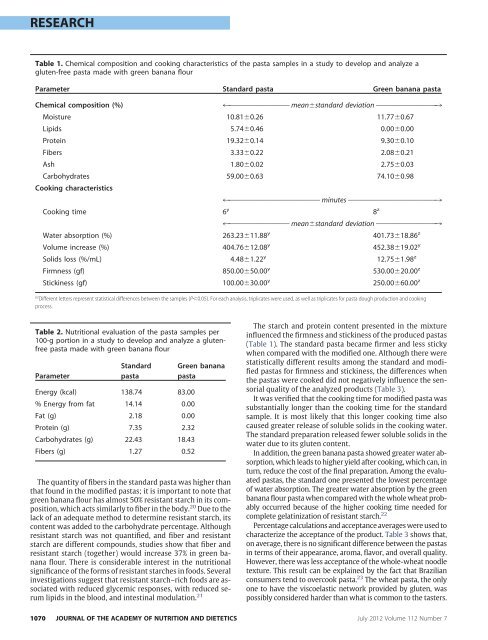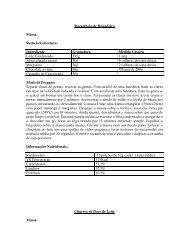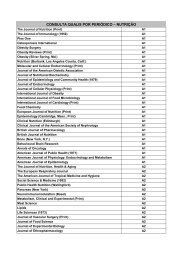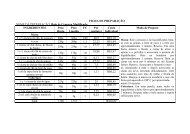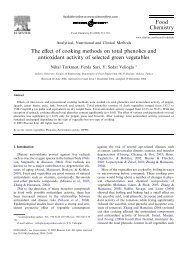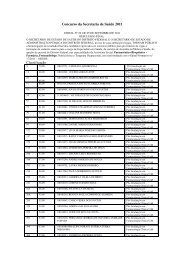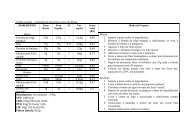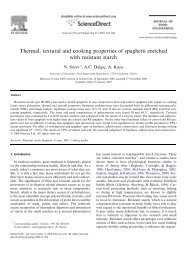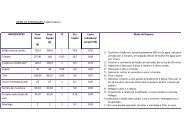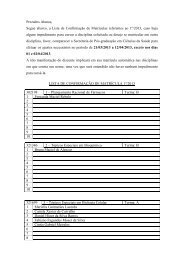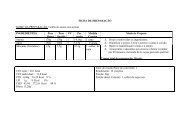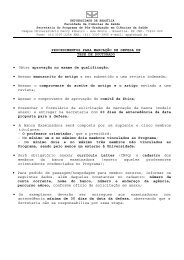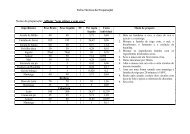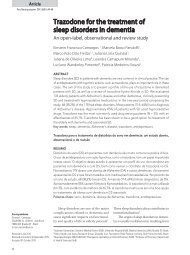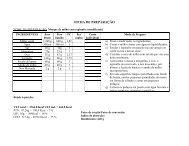Green Banana Pasta: An Alternative for Gluten-Free Diets
Green Banana Pasta: An Alternative for Gluten-Free Diets
Green Banana Pasta: An Alternative for Gluten-Free Diets
You also want an ePaper? Increase the reach of your titles
YUMPU automatically turns print PDFs into web optimized ePapers that Google loves.
RESEARCH<br />
Table 1. Chemical composition and cooking characteristics of the pasta samples in a study to develop and analyze a<br />
gluten-free pasta made with green banana flour<br />
Parameter Standard pasta <strong>Green</strong> banana pasta<br />
Chemical composition (%) 4 meanstandard deviation 3<br />
Moisture 10.810.26 11.770.67<br />
Lipids 5.740.46 0.000.00<br />
Protein 19.320.14 9.300.10<br />
Fibers 3.330.22 2.080.21<br />
Ash 1.800.02 2.750.03<br />
Carbohydrates<br />
Cooking characteristics<br />
59.000.63 74.100.98<br />
4 minutes 3<br />
Cooking time 6 y<br />
8 z<br />
4 meanstandard deviation 3<br />
Water absorption (%) 263.2311.88 y<br />
401.7318.86 z<br />
Volume increase (%) 404.7612.08 y<br />
452.3819.02 y<br />
Solids loss (%/mL) 4.481.22 y<br />
12.751.98 z<br />
Firmness (gf) 850.0050.00 y<br />
530.0020.00 z<br />
Stickiness (gf) 100.0030.00 y<br />
250.0060.00 z<br />
yzDifferent letters represent statistical differences between the samples (P0.05). For each analysis, triplicates were used, as well as triplicates <strong>for</strong> pasta dough production and cooking<br />
process.<br />
Table 2. Nutritional evaluation of the pasta samples per<br />
100-g portion in a study to develop and analyze a glutenfree<br />
pasta made with green banana flour<br />
Parameter<br />
Standard<br />
pasta<br />
Energy (kcal) 138.74 83.00<br />
% Energy from fat 14.14 0.00<br />
Fat (g) 2.18 0.00<br />
Protein (g) 7.35 2.32<br />
Carbohydrates (g) 22.43 18.43<br />
Fibers (g) 1.27 0.52<br />
<strong>Green</strong> banana<br />
pasta<br />
The quantity of fibers in the standard pasta was higher than<br />
that found in the modified pastas; it is important to note that<br />
green banana flour has almost 50% resistant starch in its composition,<br />
which acts similarly to fiber in the body. 20 Due to the<br />
lack of an adequate method to determine resistant starch, its<br />
content was added to the carbohydrate percentage. Although<br />
resistant starch was not quantified, and fiber and resistant<br />
starch are different compounds, studies show that fiber and<br />
resistant starch (together) would increase 37% in green banana<br />
flour. There is considerable interest in the nutritional<br />
significance of the <strong>for</strong>ms of resistant starches in foods. Several<br />
investigations suggest that resistant starch–rich foods are associated<br />
with reduced glycemic responses, with reduced serum<br />
lipids in the blood, and intestinal modulation. 21<br />
The starch and protein content presented in the mixture<br />
influenced the firmness and stickiness of the produced pastas<br />
(Table 1). The standard pasta became firmer and less sticky<br />
when compared with the modified one. Although there were<br />
statistically different results among the standard and modified<br />
pastas <strong>for</strong> firmness and stickiness, the differences when<br />
the pastas were cooked did not negatively influence the sensorial<br />
quality of the analyzed products (Table 3).<br />
It was verified that the cooking time <strong>for</strong> modified pasta was<br />
substantially longer than the cooking time <strong>for</strong> the standard<br />
sample. It is most likely that this longer cooking time also<br />
caused greater release of soluble solids in the cooking water.<br />
The standard preparation released fewer soluble solids in the<br />
water due to its gluten content.<br />
In addition, the green banana pasta showed greater water absorption,<br />
which leads to higher yield after cooking, which can, in<br />
turn, reduce the cost of the final preparation. Among the evaluated<br />
pastas, the standard one presented the lowest percentage<br />
of water absorption. The greater water absorption by the green<br />
banana flour pasta when compared with the whole wheat probably<br />
occurred because of the higher cooking time needed <strong>for</strong><br />
complete gelatinization of resistant starch. 22<br />
Percentage calculations and acceptance averages were used to<br />
characterize the acceptance of the product. Table 3 shows that,<br />
on average, there is no significant difference between the pastas<br />
in terms of their appearance, aroma, flavor, and overall quality.<br />
However, there was less acceptance of the whole-wheat noodle<br />
texture. This result can be explained by the fact that Brazilian<br />
consumers tend to overcook pasta. 23 The wheat pasta, the only<br />
one to have the viscoelastic network provided by gluten, was<br />
possibly considered harder than what is common to the tasters.<br />
1070 JOURNAL OF THE ACADEMY OF NUTRITION AND DIETETICS July 2012 Volume 112 Number 7


